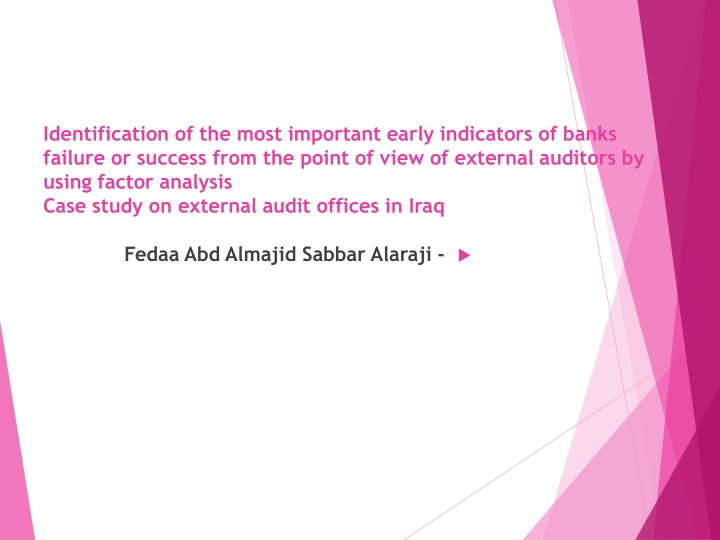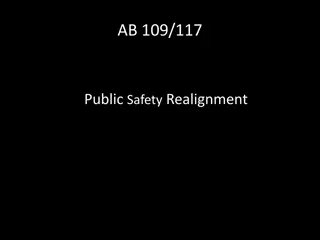
Early Indicators of Banks' Success and Failure: External Auditors' Perspective in Iraq
Explore the crucial early indicators of banks' success or failure as perceived by external auditors in Iraq. The study delves into the factors influencing the continuity of banks' operations, emphasizing the responsibility of external auditors in predicting potential financial setbacks. Gain insights into the theoretical framework, field study, and conclusions regarding this significant topic.
Uploaded on | 0 Views
Download Presentation

Please find below an Image/Link to download the presentation.
The content on the website is provided AS IS for your information and personal use only. It may not be sold, licensed, or shared on other websites without obtaining consent from the author. If you encounter any issues during the download, it is possible that the publisher has removed the file from their server.
You are allowed to download the files provided on this website for personal or commercial use, subject to the condition that they are used lawfully. All files are the property of their respective owners.
The content on the website is provided AS IS for your information and personal use only. It may not be sold, licensed, or shared on other websites without obtaining consent from the author.
E N D
Presentation Transcript
Identification of the most important early indicators of banks failure or success from the point of view of external auditors by using factor analysis Case study on external audit offices in Iraq Fedaa Abd Almajid Sabbar Alaraji -
Introduction The continuity in the activity of companies in general and banks in particular has big importance for internal and external parties, represented by the relationship between investors and management, government agencies and other parties. External audit has the role of overseeing this relationship by determining the most important factors and indicators which give an early warning on the continuity of the bank s activity or its failure over the next period. In recent years, studies and research have focused on determining most factors and indicators which can be used for foreseeing the bank s continuity or its financial failure. This happened especially after the financial collapses of many international banks without there being any early warning signs from the external audit offices responsible for auditing those banks regarding existing factors and indicators of failure. Over the following period, this caused a trust and credibility crisis in the profession of external auditing. The purpose of the current study is to highlight the financial failure signs for banking institutions which lead to withdrawal of these institutions from the market, in case failure is not predicted in early stages. The international standard of audit number 570 requires from external audit to perform as many procedure as necessary in order to ensure the financial requirements have been prepared in accordance with the hypothesis of business continuity. The responsibility of the external auditor is to predict the financial failure of the company or its ability to continue its activity. Also, the importance of the present study is to complete the studies and research regarding this topic in the Iraqi environment. The study includes three sections. The first section covers the theoretical framework which includes five paragraphs as follows: previous studies, the importance of banks continuity, responsibility of external auditor, procedures imposed on the external auditor and duties of external auditor. The second section covers the field study and the third section highlights the conclusions.
There are various factors and indicators that the external auditor should take into consideration in order to be able to evaluate the ability of banks to continue their activity (Thenibat, 1991). Numerous professional studies are interested applications to determine the importance of the factors and of the financial, operational and legal indicators which can be used as signals about the possibility of continuity or failure. These studies determine the relative importance of those indicators and factors according to international and local environment in which they work. The most important these factors and indicators are academic research their and and in study Procedures imposed on the external auditor to secure their commitment to the work of ensuring the continuity of the banks included in the following paragraphs.
continu According Jrboe (2001) the financial indicators are as follows: - Net liabilities and circulation liabilities: when liabilities are more than assets issues may occur in the ability of banks to meet their obligations. - The loans and possibility of repayment: banks cannot repay their long- term loans so this will continue in the accumulation of debts. Therefore, the bank is no longer be able to continue its activity. - Suffering from substantial and recurring losses: recurring of losses that have physical impact on banks, leading to their physical disability and thus weakening the ability of the banks to continue, thus decreasing share prices in the financial markets. - Profit not distributed: the profit is not distributed to shareholders in the following period, although the exact profit is distributable in the financial statements. The banks distribute stock instead of profits. There will be no justification for the increase of capital by the amount of the distributed stock which will lead to a decline in the confidence of the shareholders of those banks, which also reduces their share prices in the financial markets.
continu The operational indicators are detailed below: - Loss of a major market, concession or license - Important management positions are empty of leadership and it is not possible to bring alternatives - The existence of problems and difficulties in dealing with the crises in employment or access to important operating requirements The following are considered as legal indicators: - Non-compliance with legal requirements, such as lack of capital adequacy in banks - Changes in laws and government policies There also might be taken into account other internal procedures: - Inefficiency of user accounting system - Intermittent activity interruptions due to operating difficulties - Non-economic linked to long-term (Kaplan and Krumvried, 2001) The focus of the current study is on the most important indicators that can give early warning about vulnerability of the banking companies to financial failure or the possibility of continuing working in the coming period.
Conclusion Through theoretical study and analysis of the data under study, this paper reached the results detailed below. External audit profession has an important supervisory role on the active banks by identifying factors and indicators which give an early warning about the banks continuity or their potential financial failure in the near future. There are financial, operational, legal and other factors and indicators which can be used by external auditors to determine the continuity or failure of the bank. Some of these results were reached by means of conventional ordinary tests by external auditors. Some auditors employed extensive effort, testing and costs in order to achieve these results. The external auditor is considered responsible for evaluating the continuity of the activity of banks or their financial failure; the external auditor is considered careless in case of not taking the necessary professional care in the evaluation. The positive or inverse correlations between factors and indicators and their impact on financial failure are shown in table 2. The factors and indicators have various relative importance which is used in evaluating the continuation of the banking activity or financial failure according to the opinion of the external auditor.






















